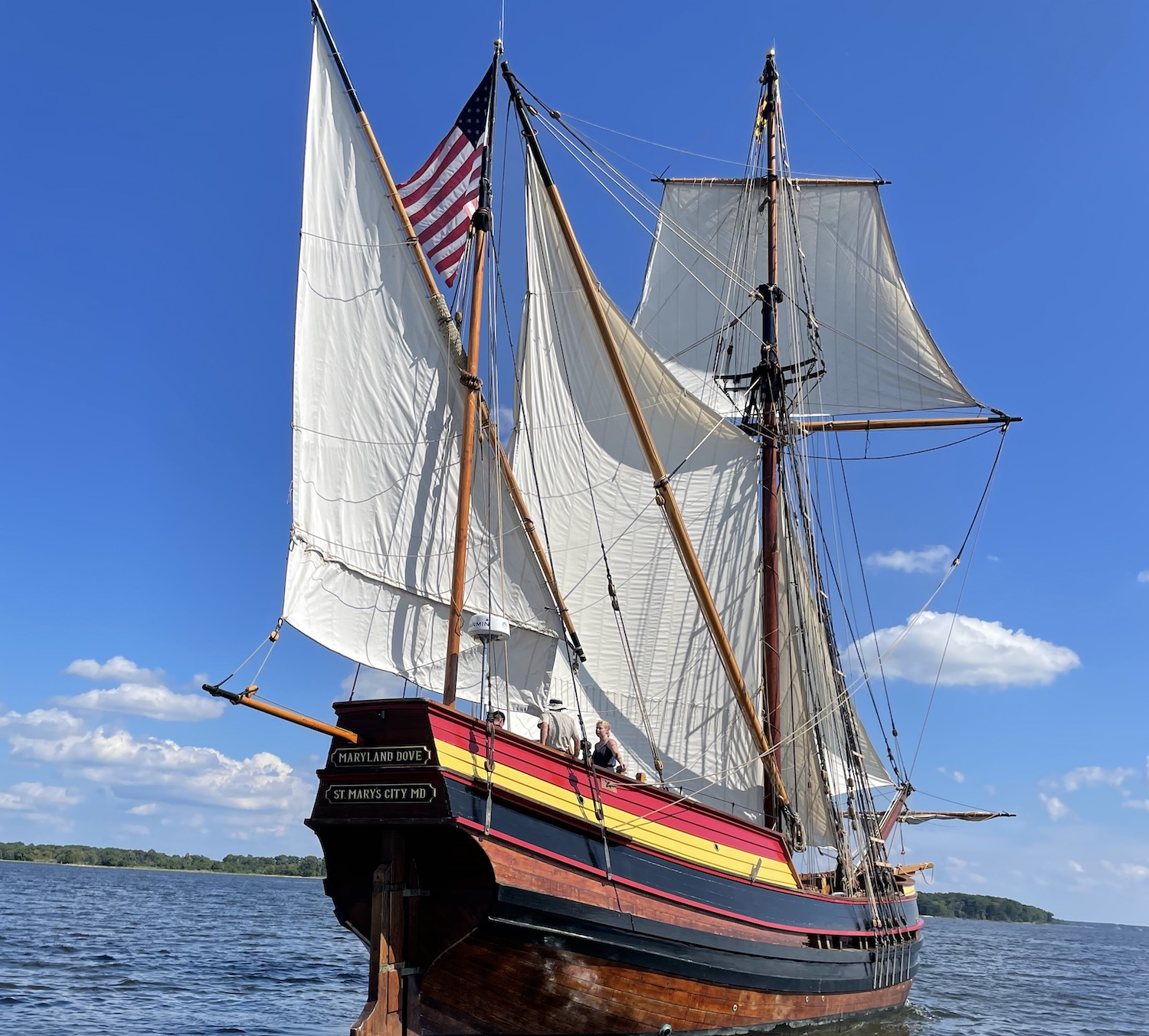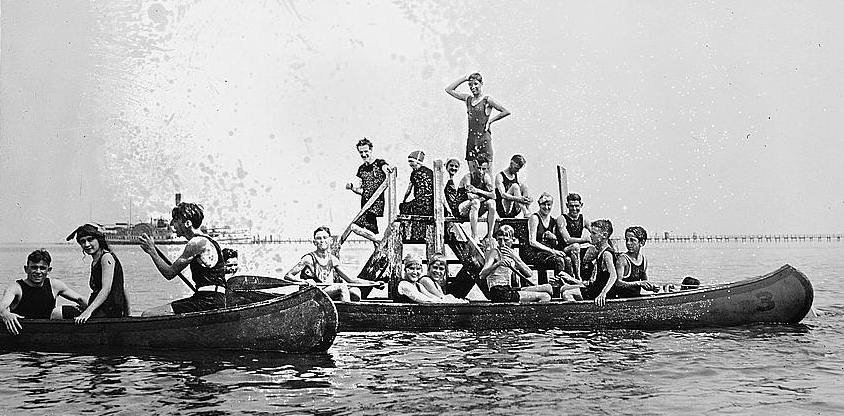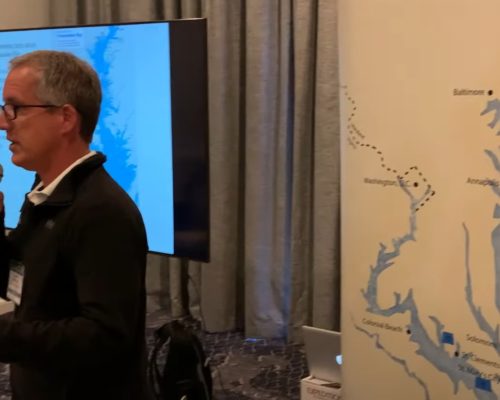Maryland Dove sets sail
I’m one of the first people to sail on the new Maryland Dove, and it’s not at all what I expected. I was ready to step through a thin place between now and 400 years ago and enjoy a little on-the-water time travel. What I got was an experience more like riding in the passenger seat of a very complicated new car while it’s being driven off the lot. The woodwork on her is so fresh that it’s still a little tacky. The sails are a snowy laundry white. There’s not a frayed line anywhere, and from the waterline, her hull paint is so bright and shiny you can almost see your reflection.
This new Dove is a love letter to period authenticity.
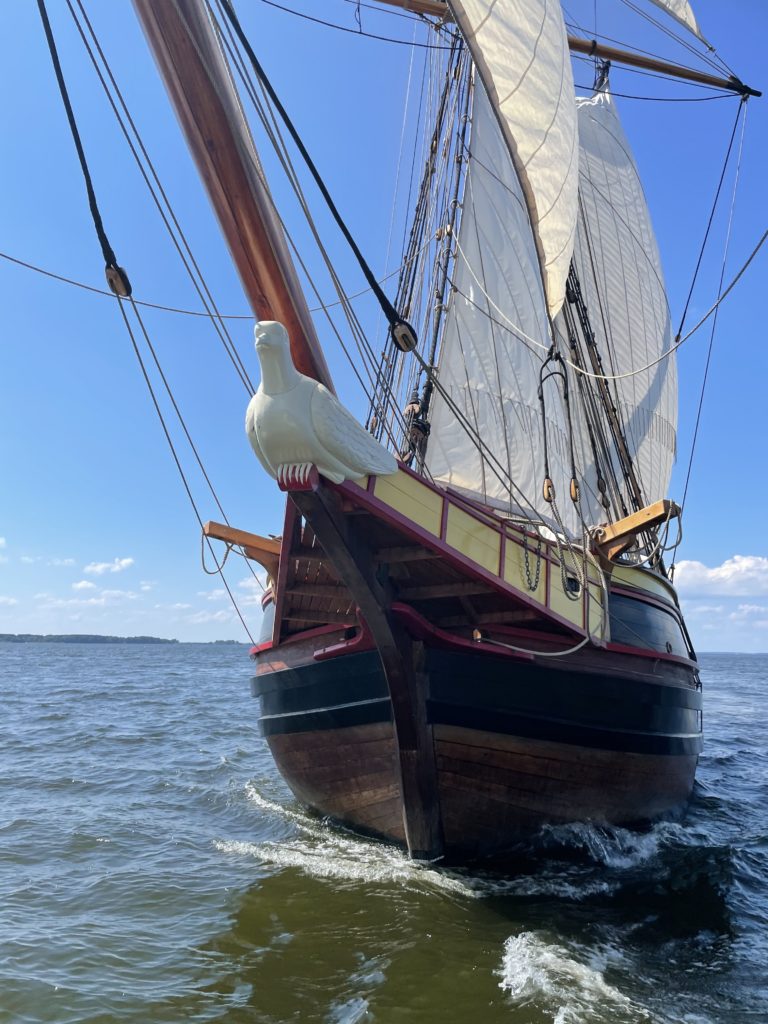
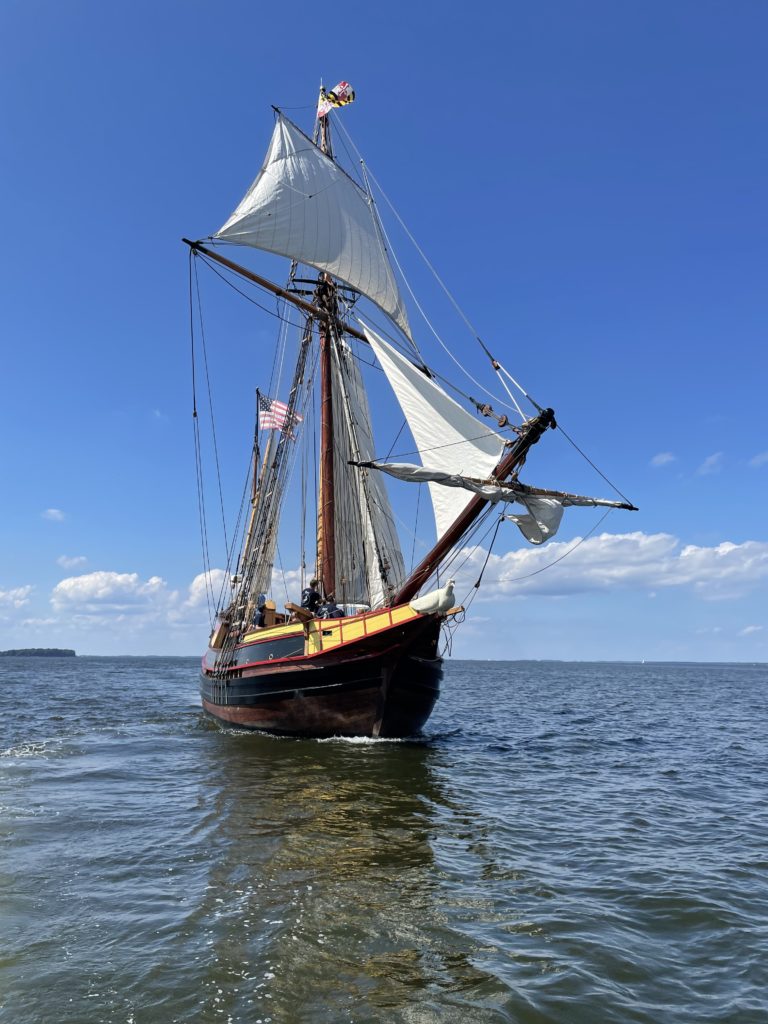
The new feeling clearly extends to the captain and crew. Whereas a normal tall ship cruise is a little like watching an intricate ballet of familiar tasks, today the crew on Dove is still trying to learn the ropes—literally. As the crew begins to raise the sails, the staysail gets stuck. There’s some time spent trying to adjust the lines, with Captain Will Gates calling back and forth with first mate Jeremy Heveron as they try to decide which one needs tightening. Marlee Putnam, the waterfront education supervisor, looks over at John Fulchiron, a volunteer crew. “Is it muscle memory yet?” she asks. “Getting there,” he says.
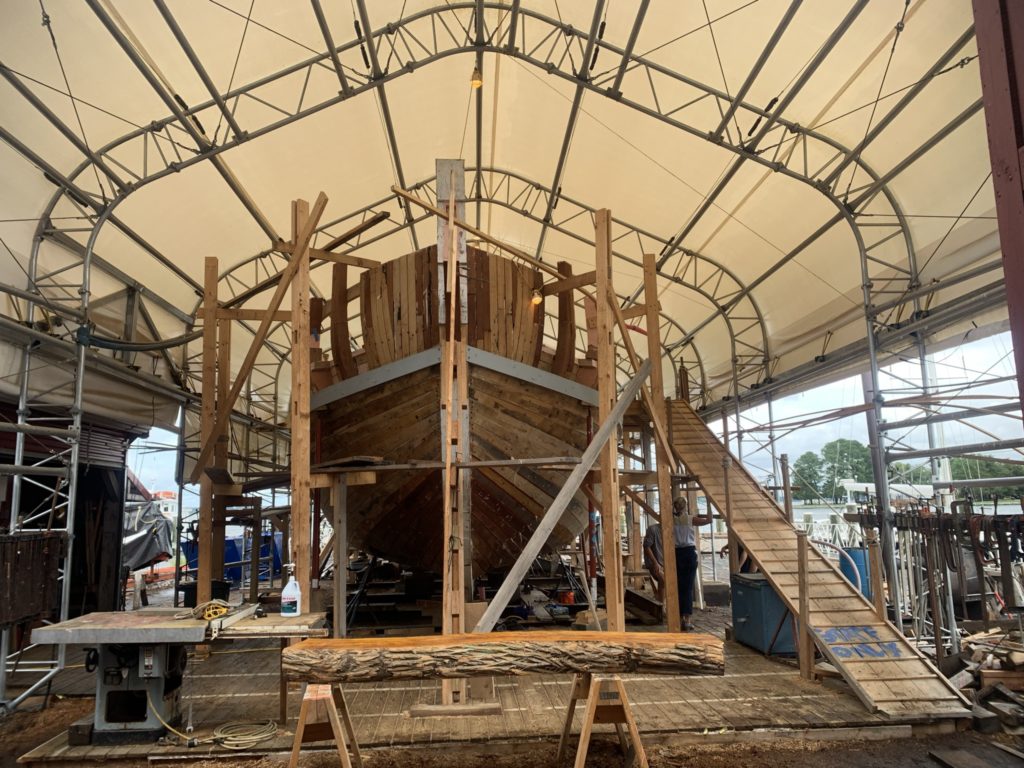
Jim Knowles, the crew shipwright, has worked at Historic St Mary’s City for eight years, since the days when a new Dove seemed like a very distant dream. “It’s all different than the old boat,” he says. “It’s easier in a way than a squaresail. The spritsail especially is very complex and large, and there’s all these little nuances to learn. We haven’t gained our crew confidence yet. But we will.”
No doubt there’s a learning curve when it comes to sailing a brand new, 400-year-old tall ship. Especially one as unique as this iteration of Dove. Whereas the old vessel represented a generic tobacco trading ship, this new Dove is a love letter to period authenticity. Carefully built to reflect the original 1634 ship, 2021 Dove reflects the leaps and bounds made in maritime research and marine archaeology since the last version was constructed. Unlike the paper research of the past that relied on period accounts or old texts, this Dove’s historic accuracy was informed by actual 17th-century vessels. Thanks to technology like sidescan sonar, 3D modeling and advancements in the conservation and restoration of shipwrecks, Dove is rich in detail from vessels that sank more than 300 years ago.
The differences really show above the hull. The Jim Richardson-built ’70s Dove was square rigged, reflecting the best scholarship at the time. Today’s Dove is a marvel of 17th-century technology—a reminder that sailboats were truly the most advanced machines of that age. Nothing makes that clearer than standing below her rigging and looking up. An intricate webbing of lines, sails and custom-built blocks tangle overhead, all designed to sail close to the wind whether off the coast or on a transatlantic voyage.
“And here she is—a dream realized, a dream we can all share.”
Maryland Dove Captain Will Gates
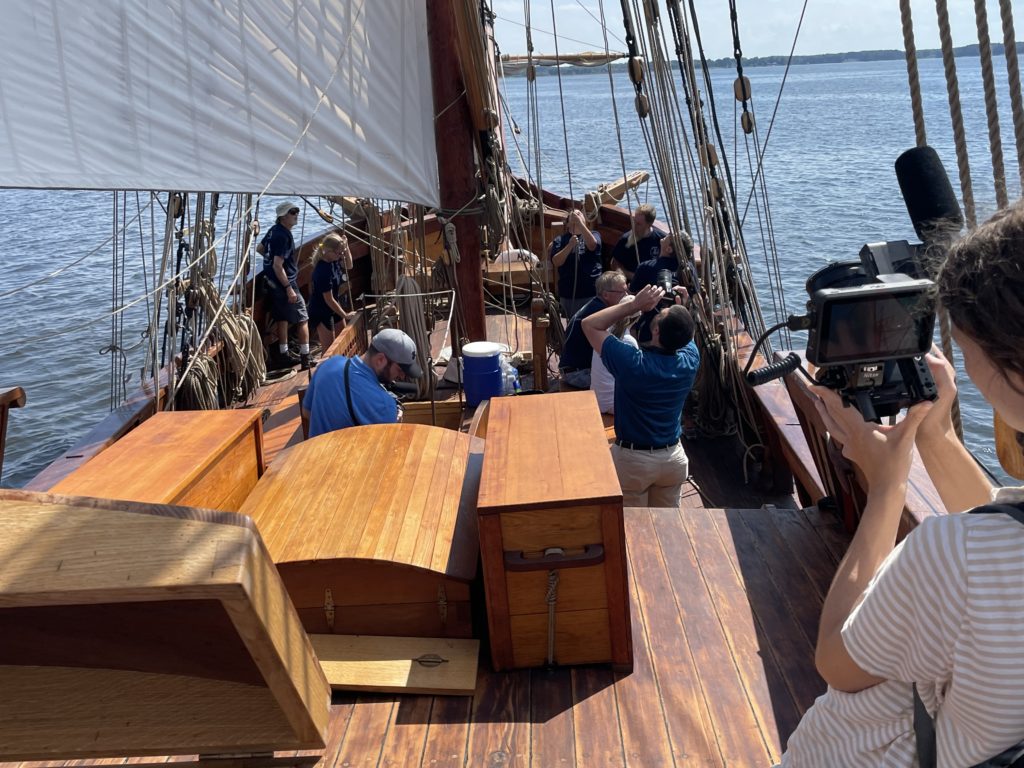
Meet Maryland Dove
From 2019 to 2022, the Chesapeake Bay Maritime Museum worked closely with Historic St. Mary’s City and naval architect Iver Franzen on the design and construction of the new Maryland Dove. Built to replace the aging 1977 Dove, Maryland Dove brings a new level of period authenticity and historic detail to Maryland’s signature flagship.
Known for his work with tall ships such as Pride of Baltimore II, Kalmar Nyckel and USS Constitution, Franzen designed Maryland Dove to closely reflect the form and function of the original vessel that sailed to the Maryland colony with Ark in 1634. Unlike the larger passenger ship Ark, Dove was a small and nimble trading vessel, well suited for navigating the shallow waterways of the Chesapeake and beyond during the establishment of the colony and its first capital.
- Year Launched: 2022
- Shipyard: Chesapeake Bay Maritime Museum
- Owner/Operator: Historic St. Mary’s City Commission
- Length Overall: 84′
- Length on Deck: 57′
- Length at Waterline: 51′
- Beam: 17′
- Draft: 8′
- Height of Main Mast: 64′
- Sail Area: 2,019 sq ft.
The new Maryland Dove will serve as Historic St. Mary’s City’s floating ambassador and one of its signature exhibits. After a short outreach tour in September of 2022, Maryland Dove returns to Historic St. Mary’s City where it will be open to the public as a dockside exhibition and on-the-water experience.
If it looks authentic, it is. Dove boasts a kind of rigging that’s been largely lost to time: the Boyer rig. Prior to the start of the build, a brain trust of maritime architects, historians and shipwrights from the Chesapeake Bay Maritime Museum and Historic St. Mary’s City pooled their knowledge, poring over 17th-century charts, models and Dutch Renaissance paintings to figure out precisely what the sail plan might have been. Then the museum sent shipwrights Joe Connor and Sam Hiltgartner to Sweden to explore an actual recovered 17th-century Swedish warship, Vasa. The result is a mashup of art history and applied archaeology: a flexible Boyer rig with a combination of lateen and square sails that could sail the shallow waterways of the East Coast on trading missions and cross the expanse of the ocean.
The old-is-new Boyer rig will make Captain Will Gates’ life a little easier.
“It was my wish when we started that we’d end up with something that is more accurately representative of the original 1634 vessel, and we have,” says Gates. “But we also have a vessel that’s a little handier in the waters that we’re sailing, and meets the modern needs of the program with Coast Guard safety standards while combining historical accuracy.”
Gates is unsentimental about the upgrade. “It was an albatross to maintain that rickety boat,” he says, referring to the ’70s Dove. “It wasn’t a job, it was a lifestyle. I’d wake up at midnight to check the bilge.”
The crew seems happy about it too. Ask Marlee Putnam what her favorite part of this brand-new ship is, and she’s quick to answer. “This is the only Boyer rig in North America. Minus the Pinnace Virginia in Maine, but they’ve been working on that build for a long time—ten years maybe? Anyway, until Virginia’s done, we’re it.”
The rigging design also addresses an awkward problem for the staff at HSMC. Visitors to the historic site would head down to the waterfront to explore Maryland Dove and assume they were stepping onboard a period-accurate vessel. So for decades, the educators working on Dove would greet everyone with a little preamble—yes, this Dove represents a kind of ship from Maryland’s past, but it’s not based on the real 1634 Dove.
Understandably, it was confusing at best, disappointing at worst, and over time it became increasingly problematic. Visitors to the site have only become more savvy and rightly expect a historic site like HSMC to bring not just facts but authenticity to their experience.
“It’s important to meet our visitor’s expectations,” says Peter Friesen, Director of Education at Historic St. Mary’s City. “They expect the ship to be an authentic representation of the 1634 Dove, rather than the 1970s tobacco trading vessel named in honor of Dove. The organization wants to tell a more nuanced history, and this new ship will be a big part of that.”
For Friesen and the staff of Historic St. Mary’s City, this new, accurate Dove is just one of the ways the organization is refining its storytelling to reflect a broader approach towards history—one that encompasses Native American history as well as the stories of the colonists, and that uses personal histories to build empathy across the centuries. There are currently expanded tours, a fresh approach to interpretation, and a new visitor’s center soon to break ground. It’s an exciting chapter for the organization with Dove as the flagship experience. “We’ll have more time now to talk about that beginning voyage to establish a colony,” Friesen says. “And with the recent discovery of St. Mary’s Fort, we can help visitors understand a broader story of colonization—of force, of violence, of a race for resources to use in trade.”
Dove will be a big part of how that story gets told, whether as a dockside on-the-water exhibit for visitors to explore, or eventually for cruises on the St. Mary’s River. A slate of annual outreach voyages is also up for consideration, especially now that Maryland Dove has a rig that can be sailed with ease.
But all of that is in the future. For now, there’s just the open water of the Miles River on a warm summer day, a fine wind filling the gleaming white sails of the new Maryland Dove. Captain Gates opens her up, wake cresting behind us, while the crew squints into the sun and calls back and forth, finding a groove. The mood is buoyant.
“It’s big and it moves and it works,” Gates says. “It’s a living, almost breathing thing.” For Gates, sailing Dove is setting the capstone on over 20 years of lobbying, prepping, working. And here she is—a dream realized, a dream we can all share. “Dove is a big part of our Maryland story,” Gates says. “And even though a lot of people know about it, I invite everybody to come visit her and see there’s still so much more to learn.”
To plan your visit to Historic St Mary’s City, or to learn more about Maryland Dove, visit hsmcdigshistory.org.

